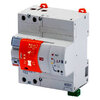It's a bit of a two-edged sword. If you believe that things like 'spikes' can result in (presumably 'idiosyncratic', not predictable) 'nuisance trips' of residual current devices (RCDs or RCBOs), then it presumably follows that the more such devices you have, the more such 'nuisance trips' you will experience (although admittedly with each trip affecting less things).?
Kind Regards, John
If the RCD has an indicator to say this item is close to tripping

as with the Eaton X-Pole, then you know when you are sailing close to the wind, and can take action.
We are told 9 mA is the limit to back ground leakage with a 30 mA trip, and the trip can activate anywhere between 15 and 30 mA i.e. 50% to 100% the Eaton X-Pole claims 90% to 100%, but over the years RCD's have moved on, I had considered one of these

auto resetting units, but latter editions of BS 7671 it seems stopped there use with domestic, and the introduction of type AC, A, F, B and S adds more confusion. Since single module width RCBO's are as far as I know only available as type AC and A, there are likely cases where EV charging or solar panels are used when RCBO's can't be used. The type testing of the consumer unit is only valid if using recommended items in the unit, so we are not permitted to mix and match with domestic.
Also from experience I have found early RCD's could fail due to strain on the housing from the connecting wires, so the unit should be tested after being fitted, but the instructions say it should be tested when no circuits connected, add this to manufacturers instructions that the time to trip is only valid when tested as a type AC, yet we see a selection on the tester for type A, or more, the whole situation is rather unclear.
My RCD tester my son took when his failed, so no longer have one. But I know the two RCD's I had passed the test, and the installation passed the test with the mega, so there was no reason why it should trip to my knowledge. However an insulation tester (mega) uses DC, and the supply is AC, so there can be inductive or capacitive links causing a leakage which the insulation tester would not show, so in theory we should use the clamp-on ammeter, mine starts at 0.1 amp so useless for this test, my son the same, so we could not test the installation for back ground leakage, so easy way out was all RCBO's, it is unlikely a single circuit will exceed 9 mA leakage.
In the main we use the standard installation or minor works form as a check list as to what should be tested, and there is nothing including the EICR form asking for the back ground leakage to be measured or recorded, so many, including myself, don't measure back ground leakage, so an installation can be right on the edge, and a couple of extra mA to imbalance is enough to cause a trip. And a spike or surge can be enough to tip it over the edge.
I was of your thinking when considering what to do in my last house, fit RCBO's or auto resetting RCD, at that time still permitted. But mothers house with two RCD's and 6 RCBO's did not trip ever, and there are some regular posters on this forum who report their RCD never trips, but we can only guess as to why. Or to put is another way, why they do trip in some homes with no apparent fault.
Yes my RCBO's have tripped, one with good reason, the roof was leaking, and socket wet, possible other trip on shower was due to same leak, but I only lost circuits in the flat under the main house, the main house was unaffected, and BS 7671 says "Every installation shall be divided into circuits, as necessary, to (iii) take account of danger that may arise from the failure of a single circuit such as a lighting circuit (iv) reduce the possibility of unwanted tripping of RCDs due to excessive protective conductor currents produced by equipment in normal operation" and I question how this can be complied with when there are only one or two RCD's fitted, clearly there can be compliance, for example in a caravan where you have battery powered lights.
The problem for the electrician is he has no idea during the design stage what equipment will be normally in operation. We have all seen how the older computers would trip a RCD, together with many items using filters to stop spikes. 3.5 mA is the limit for equipment having a protective conductor current (
543.7.1.1) so once more than 15/3.5 = 4 sockets are used, the RCD could trip without fault, OK unlikely, but it does put into question how we can design an installation with more than one socket circuit on the same RCD.
I have seen how a TT installation has had the 100 mA RCD swapped for a 30 mA, and in some cases it does hold, but the big question, does it present a potential danger? I have heard and seen it said we can loose the DNO supply so it is no worse to loosing DNO supply, however if the RCD trips for good cause, it is likely some one could be injured, and to plunge into darkness as well is a potential danger? So should it fail as a code C2 with an EICR?



